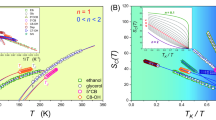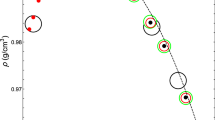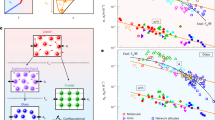Abstract
The alternating support for and denial of a glass transition for amorphous water at 136 K has resumed after a hiatus of 20 years, during which it seemed secure. We revived the alternative interpretation1 by looking again at the calorimetric signal that previously provided the most direct evidence for the glass transition2,3 — and now Kohl et al.4 present new data to support the original interpretation. We show here that their results are also consistent with our conclusions.
This is a preview of subscription content, access via your institution
Access options
Subscribe to this journal
Receive 51 print issues and online access
$199.00 per year
only $3.90 per issue
Buy this article
- Purchase on Springer Link
- Instant access to full article PDF
Prices may be subject to local taxes which are calculated during checkout

Similar content being viewed by others
References
Yue, Y. -Z. & Angell, C. A. Nature 427, 717–720 (2004).
Johari, G. P., Hallbrucker, A. & Mayer, E. Nature 330, 552–553 (1987).
Hallbrucker, A., Mayer, E. & Johari, G. P. J. Phys. Chem. 93, 4986–4990 (1989).
Kohl, I., Bachmann, L., Mayer, E., Hallbrucker, A. & Loerting, T. Nature 435, doi: 10.1038/nature03707 (2005).
Ito, K., Moynihan, C. T. & Angell, C. A. Nature 398, 492–495 (1999).
Starr, F. W., Angell, C. A. & Stanley, H. E. Physica A 323, 51–66 (2003).
Faraone, A., Liu, L., Mou, C. -Y., Wen, C. -W. & Chen, S. -H. J. Chem. Phys. 121, 10843–10846 (2004).
Maruyama, S., Wakabayashi, K. & Oguni, M. Am. Inst. Phys. Conf. Proc. 473, 675–676 (2004).
Angell, C. A. et al. J. Phys. Condens. Matter 15, S1051–S1068 (2003).
Johari, G. P. J. Chem. Phys. 119, 2935–2937 (2003).
Velikov, V., Borick, S. & Angell, C. A. Science 294, 2335–2338 (2001).
Moynihan, C. T., Easteal, A. J., DeBolt, M. A. & Tucker, J. J. Am. Ceram. Soc. 59, 12–16 (1976).
Boehm, L., Ingram, M. D. & Angell, C. A. J. Non-Cryst. Solids 44, 305–313 (1981).
Mishima, O. J. Chem. Phys. 121, 3161–3164 (2004).
Author information
Authors and Affiliations
Corresponding author
Rights and permissions
About this article
Cite this article
Yue, Y., Angell, C. Glass transition in hyperquenched water? (reply). Nature 435, E1–E2 (2005). https://doi.org/10.1038/nature03708
Published:
Issue Date:
DOI: https://doi.org/10.1038/nature03708
Comments
By submitting a comment you agree to abide by our Terms and Community Guidelines. If you find something abusive or that does not comply with our terms or guidelines please flag it as inappropriate.



